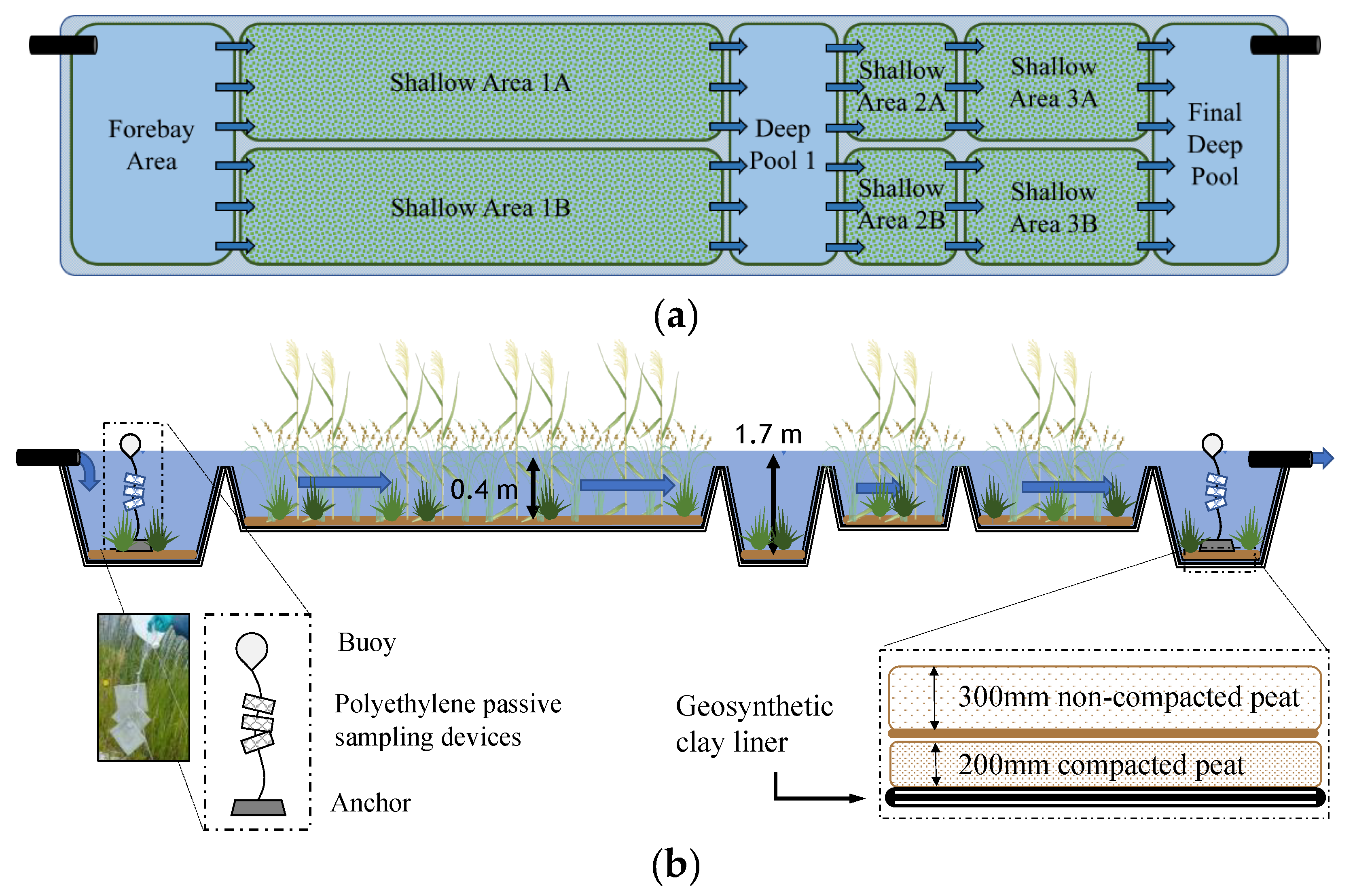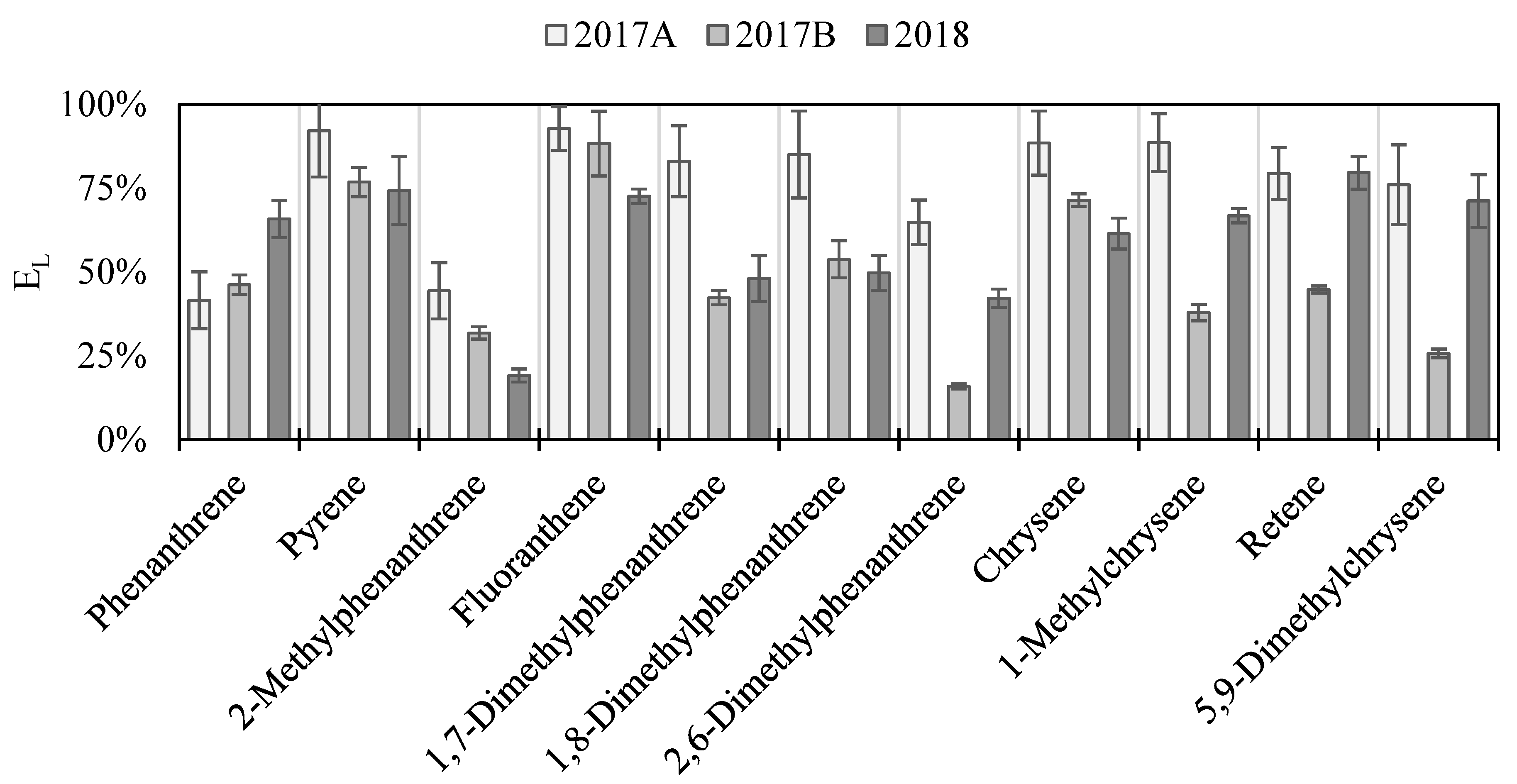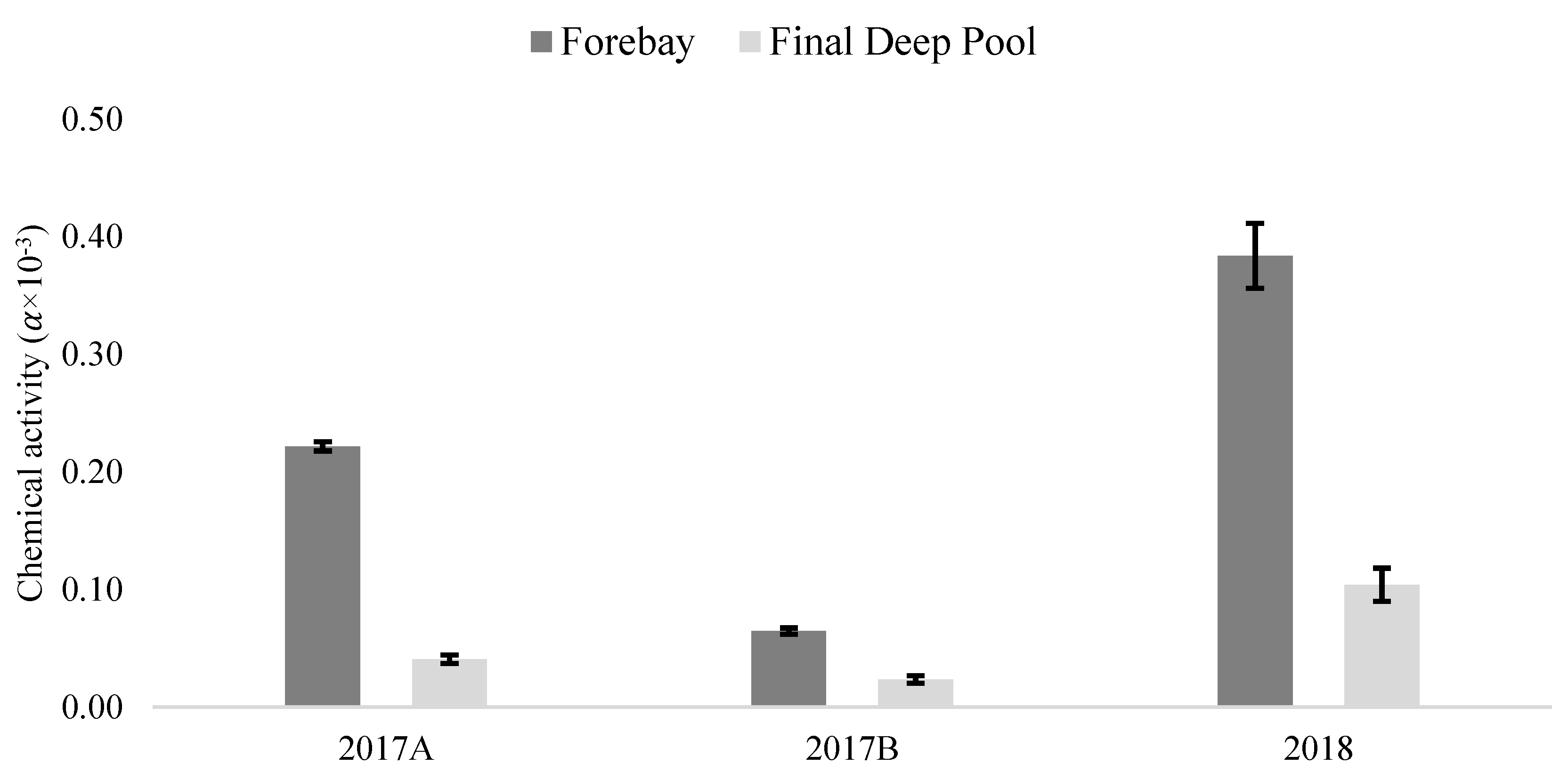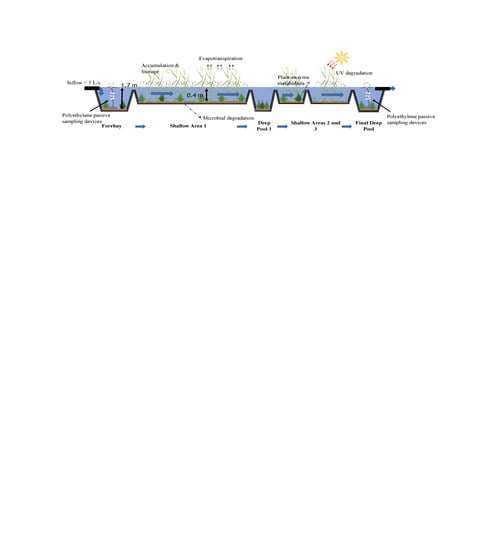Treatment of Polycyclic Aromatic Hydrocarbons in Oil Sands Process-Affected Water with a Surface Flow Treatment Wetland
Abstract
1. Introduction
2. Materials and Methods
2.1. Site Description
2.2. Water Quality Monitoring
2.3. Passive Sampling
2.4. Data Analysis
2.5. Wetland Treatment Performance Evaluation
2.5.1. Concentration-Reduction
2.5.2. Mass Removal
2.5.3. Toxicity
3. Results and Discussion
3.1. Water Quality
3.2. Polycyclic Aromatic Hydrocarbons in Influent
3.3. Wetland Treatment Performance
Toxicity
4. Conclusions
Supplementary Materials
Author Contributions
Funding
Acknowledgments
Conflicts of Interest
References
- Holowenko, F.M.; Mackinnon, M.D.; Fedorak, P.M. Characterization of naphthenic acids in oil sands wastewaters by gas chromatography-mass spectrometry. Water Res. 2002, 36, 2843–2855. [Google Scholar] [CrossRef]
- Collier, T.K.; Anulacion, B.F.; Arkoosh, M.R.; Dietrich, J.P.; Incardona, J.P.; Johnson, L.L.; Myers, M.S. Effects on Fish of Polycyclic Aromatic Hydrocarbons (PAHs) and Naphthenic Acid Exposures. Fish. Physiol. 2013, 33, 195–255. [Google Scholar] [CrossRef]
- Alharbi, H.A.; Morandi, G.; Giesy, J.P.; Wiseman, S.B. Effect of oil sands process-affected water on toxicity of retene to early life-stages of Japanese medaka (Oryzias latipes). Aquat. Toxicol. 2016, 176, 1–9. [Google Scholar] [CrossRef] [PubMed]
- Li, C.; Fu, L.; Stafford, J.; Belosevic, M.; Gamal El-Din, M. The toxicity of oil sands process-affected water (OSPW): A critical review. Sci. Total Environ. 2017. [Google Scholar] [CrossRef] [PubMed]
- Kelly, E.N.; Short, J.W.; Schindler, D.W.; Hodson, P.V.; Ma, M.; Kwan, A.K.; Fortin, B.L. Oil sands development contributes polycyclic aromatic compounds to the Athabasca River and its tributaries. Proc. Natl. Acad. Sci. USA 2009, 106, 22346–22351. [Google Scholar] [CrossRef] [PubMed]
- Remillard, C. Picturing environmental risk: The Canadian oil sands and the National Geographic. Int. Commun. Gaz. 2011, 73, 127–143. [Google Scholar] [CrossRef]
- Jasechko, S.; Gibson, J.J.; Jean Birks, S.; Yi, Y. Quantifying saline groundwater seepage to surface waters in the Athabasca oil sands region. Appl. Geochem. 2012, 27, 2068–2076. [Google Scholar] [CrossRef]
- Ahad, J.M.E.; Jautzy, J.J.; Cumming, B.F.; Das, B.; Laird, K.R.; Sanei, H. Sources of polycyclic aromatic hydrocarbons (PAHs) to northwestern Saskatchewan lakes east of the Athabasca oil sands. Organ. Geochem. 2015, 80, 35–45. [Google Scholar] [CrossRef]
- Buchberger, S.G.; Shaw, G.B. An approach toward rational design of constructed wetlands for wastewater treatment. Ecol. Eng. 1995, 4, 249–275. [Google Scholar] [CrossRef]
- Knight, R.L.; Kadlec, R.H.; Ohlendorf, H.M. The use of treatment wetlands for petroleum industry effluents. Environ. Sci. Technol. 1999, 33, 973–980. [Google Scholar] [CrossRef]
- Wallace, S.; Davis, B. Engineered Wetland Design and Applications for On-Site Bioremediation of PHC Groundwater and Wastewater. SPE Proj. Facil. Constr. 2009, 4, 1–8. [Google Scholar] [CrossRef][Green Version]
- Kadlec, R.; Wallace, S. Treatment Wetlands, 2nd ed.; Taylor & Francis Group: Boca Raton, FL, USA, 2009. [Google Scholar]
- Sundaravadivel, M.; Vigneswaran, S. Constructed wetlands for wastewater treatment. Crit. Rev. Environ. Sci. Technol. 2001, 31, 351–409. [Google Scholar] [CrossRef]
- US EPA. Free Water Surface Wetlands for Wastewater Treatment: A Technology Assessment; US EPA: Washington, DC, USA, 1999. Available online: http://water.epa.gov (accessed on 1 February 2018).
- McQueen, A.D.; Hendrikse, M.; Gaspari, D.P.; Kinley, C.M.; Rodgers, J.H.; Castle, J.W. Performance of a hybrid pilot-scale constructed wetland system for treating oil sands process-affected water from the Athabasca oil sands. Ecol. Eng. 2017, 102, 152–165. [Google Scholar] [CrossRef]
- Knight, R.L.; Payne, V.W.E.B.; Borer, R.E.; Clarke, R.A.D.; Pries, J.H. Constructed wetlands for livestock wastewater management. Ecol. Eng. 2000, 15, 41–45. Available online: www.elsevier.com/locate/ecoleng (accessed on 1 February 2018). [CrossRef]
- Cameron, K.; Madramootoo, C.; Crolla, A.; Kinsley, C. Pollutant removal from municipal sewage lagoon effluents with a free-surface wetland. Water Res. 2003, 37, 2803–2812. [Google Scholar] [CrossRef]
- Abira, M.A.; van Bruggen, J.J.A.; Denny, P. Potential of a tropical subsurface constructed wetland to remove phenol from pre-treated pulp and papermill wastewater. Water Sci. Technol. 2005, 51, 173–176. [Google Scholar] [CrossRef]
- Matamoros, V.; García, J.; Bayona, J.M. Organic micropollutant removal in a full-scale surface flow constructed wetland fed with secondary effluent. Water Res. 2008, 42, 653–660. [Google Scholar] [CrossRef]
- Díaz, F.J.; Chow, A.T.; O’Geen, A.T.; Dahlgren, R.A.; Wong, P.K. Effect of constructed wetlands receiving agricultural return flows on disinfection by product precursors. Water Res. 2009, 43, 2750–2760. [Google Scholar] [CrossRef]
- Hijosa-Valsero, M.; Matamoros, V.; Sidrach-Cardona, R.; Martín-Villacorta, J.; Bécares, E.; Bayona, J.M. Comprehensive assessment of the design configuration of constructed wetlands for the removal of pharmaceuticals and personal care products from urban wastewaters. Water Res. 2010, 44, 3669–3678. [Google Scholar] [CrossRef]
- Wang, Q.; Kelly, B.C. Occurrence, distribution and bioaccumulation behaviour of hydrophobic organic contaminants in a large-scale constructed wetland in Singapore. Chemosphere 2017, 183, 257–265. [Google Scholar] [CrossRef]
- Lohmann, R. Critical review of low-density polyethylene’s partitioning and diffusion coefficients for trace organic contaminants and implications for its use as a passive sampler. Environ. Sci. Technol. 2012, 46, 606–618. [Google Scholar] [CrossRef] [PubMed]
- U.S. EPA. Estimation Programs Interface Suite™ for Microsoft® Windows, v4.11; United States Environmental Protection Agency: Washington, DC, USA, 2013.
- Ghosh, U.; Driscoll, K.; Burgess, R.M.; Jonker, M.T.O.; Reible, D.; Gobas, F.; Choi, Y.; Apitz, S.E.; Maruya, K.A.; Gala, W.R.; et al. Passive Sampling Methods for Contaminated Sediments: Practical Guidance for Selection, Calibration, and Implementation. Integr. Environ. Assess. Manag. 2014, 10, 210–223. [Google Scholar] [CrossRef]
- Burgess, R.M.; Lohmann, R.; Schubauer-Berigan, J.P.; Reitsma, P.; Perron, M.M.; Lefkovitz, L.; Cantwell, M.G. Application of passive sampling for measuring dissolved concentrations of organic contaminants in the water column at three marine superfund sites. Environ. Toxicol. Chem. 2015, 34, 1720–1733. [Google Scholar] [CrossRef] [PubMed]
- SAS Institute Inc. JMP®, Version 13.1.0; SAS Institute Inc.: Cary, NC, USA, 1989–2016. [Google Scholar]
- Alberta Climate Information Services. Current and Historical Alberta Weather Station Data Viewer. Retrieved from the Alberta. 2018. Available online: https://agriculture.alberta.ca/acis/alberta-weather-data-viewer.jsp (accessed on 15 January 2018).
- Lewis, G.N. Outlines of a new system of thermodynamic chemistry. Proc. Am. Acad. Arts Sci. 1907, 43, 259–293. [Google Scholar] [CrossRef]
- Gobas, F.A.P.C.; Otton, S.V.; Tupper-Ring, L.F.; Crawford, M.A. Chemical Activity Calculator for Calculating Thermodynamic Activities of Non-Polar Organic Chemicals from Concentrations of Chemicals in Various Environ- Mental Media. Environmental Toxicology Research Group at Simon Fraser University. 2015. Available online: http://www.sfu.ca/rem/toxicology/our-models/activity-calculator.html (accessed on 2 December 2019).
- Gobas, F.A.P.C.; Mayer, P.; Parkerton, T.F.; Burgess, R.M.; van de Meent, D.; Gouin, T. A chemical activity approach to exposure and risk assessment of chemicals: Focus articles are part of a regular series intended to sharpen understanding of current and emerging topics of interest to the scientific community. Environ. Toxicol. Chem. 2018, 37, 1235–1251. [Google Scholar] [CrossRef] [PubMed]
- Reichenberg, F.; Mayer, P. Two complementary sides of bioavailability: Accessibility and chemical activity of organic contaminants in sediments and soils. Environ. Toxicol. Chem. 2006, 25, 1239–1245. [Google Scholar] [CrossRef] [PubMed]
- Schmidt, S.N.; Holmstrup, M.; Smith, K.E.C.; Mayer, P. Passive dosing of polycyclic aromatic hydrocarbon (PAH) mixtures to terrestrial spring- tails: Linking mixture toxicity to chemical activities, equilibrium lipid concentrations, and toxic units. Environ. Sci. Technol. 2013, 47, 7020–7027. [Google Scholar] [CrossRef]
- Thomas, P.; Dawick, J.; Lampi, M.; Lemaire, P.; Presow, S.; Van Egmond, R.; Arnot, J.A.; Mackay, D.; Mayer, P.; Burgos, M.G. Application of the Activity Framework for Assessing Aquatic Ecotoxicology Data for Organic Chemicals. Environ. Sci. Technol. 2015, 49, 12289–12296. [Google Scholar] [CrossRef]
- Alberta Environment Information Centre. Muskeg River Interim Management Framework for Water Quantity and Quality Summary Report; Alberta Environment Information Centre: Edmonton, AB, Canada, 2008; ISBN 978-0-7785-7631-0. [Google Scholar]
- Tao, W.; Hall, K.J.; Ramey, W. Effects of influent strength on microorganisms in surface flow mesocosm wetlands. Water Res. 2007, 41, 4557–4565. [Google Scholar] [CrossRef]
- Truu, M.; Juhanson, J.; Truu, J. Microbial biomass, activity and community composition in constructed wetlands. Sci. Total Environ. 2009, 407, 3958–3971. [Google Scholar] [CrossRef]
- Ramirez, J.; Finnerty, B. CO2 and Temperature Effects on Evapotranspiration and Irrigated Agriculture. J. Irrig. Drain. Eng. 1996, 22. [Google Scholar] [CrossRef]
- Hadad, H.R.; Maine, M.A.; Bonetto, C.A. Macrophyte growth in a pilot-scale constructed wetland for industrial wastewater treatment. Chemosphere 2006, 63, 1744–1753. [Google Scholar] [CrossRef] [PubMed]
- Klomjek, P.; Nitisoravut, S. Constructed treatment wetland: A study of eight plant species under saline conditions. Chemosphere 2005, 58, 585–593. [Google Scholar] [CrossRef] [PubMed]
- Allen, E. Process water treatment in Canada’s oil sands industry: I. Target pollutants and treatment objectives. J. Environ. Eng. Sci. 2008, 7, 123–138. [Google Scholar] [CrossRef]
- Cowie, B.R.; James, B.; Mayer, B. Distribution of total dissolved solids in McMurray Formation water in the Athabasca oil sands region, Alberta, Canada: Implications for regional hydrogeology and resource development. Am. Assoc. Pet. Geol. Bull. 2015, 99, 77–90. [Google Scholar] [CrossRef]
- Liang, Y.; Zhu, H.; Bañuelos, G.; Yan, B.; Zhou, Q.; Yu, X.; Cheng, X. Constructed wetlands for saline wastewater treatment: A review. Ecol. Eng. 2017, 98, 275–285. [Google Scholar] [CrossRef]
- Canadian Council of Ministers of the Environment (CCME). Canadian water quality guidelines for the protection of aquatic life: Introduction. In Canadian Environmental Quality Guidelines, 1999; Canadian Council of Ministers of the Environment: Winnipeg, MB, Canada, 1999. [Google Scholar]
- Environment and Climate Change Canada. Passive Sampling, Oil Sands Region. 2015. Available online: http://donnees.ec.gc.ca/data/substances/monitor/surface-water-quality-oil-sands-region/passive-sampling-oil-sands-region/ (accessed on 26 June 2020).
- Terzakis, S.; Fountoulakis, M.S.; Georgaki, I.; Albantakis, D.; Sabathianakis, I.; Karathanasis, A.D.; Manios, T. Constructed wetlands treating highway runoff in the central Mediterranean region. Chemosphere 2008, 72, 141–149. [Google Scholar] [CrossRef]
- Machate, T.; Noll, H.; Behrens, H.; Kettrup, A. Degradation of phenanthrene and hydraulic characteristics in a constructed wetland. Water Res. 1997, 31, 554–560. [Google Scholar] [CrossRef]
- Cancelli, A.M.; Gobas, F.A.P.C.; Qian, W.; Kelly, B.C. Development and evaluation of a mechanistic model to assess the fate and removal efficiency of hydrophobic organic contaminants in horizontal subsurface flow treatment wetlands. Water Res. 2019, 151, 183–192. [Google Scholar] [CrossRef]
- Bartlett, A.J.; Frank, R.A.; Gillis, P.L.; Parrott, J.L.; Marentette, J.R.; Brown, L.R.; Hooey, T.; Vanderveena, R.; McInnisa, R.; Brunswick, P.; et al. Toxicity of naphthenic acids to invertebrates: Extracts from oil sands process-affected water versus commercial mixtures. Environ. Pollut. 2017, 227, 271–279. [Google Scholar] [CrossRef]
- Redman, A.D.; Parkerton, T.F.; Butler, J.D.; Letinski, D.J.; Frank, R.A.; Hewitt, L.M.; Bartlett, A.J.; Gillis, P.L.; Marentette, J.R.; Parrott, J.L.; et al. Application of the Target Lipid Model and Passive Samplers to Characterize the Toxicity of Bioavailable Organics in Oil Sands Process-Affected Water. Environ. Sci. Technol. 2018, 52, 8039–8049. [Google Scholar] [CrossRef] [PubMed]






| Deployment 1 2017A | Deployment 2 2017B | Deployment 3 2018 | ||||||
|---|---|---|---|---|---|---|---|---|
| 13-Jul | 17-Aug | 26-Aug | 19-Sep | |||||
| Parameter | Units | Forebay | FDP | Forebay | FDP | Forebay | Forebay | WQT + |
| BOD5 | mg/L | <2.0 | <2.0 | <2.0 | <2.0 | --- | 2 | 2.4 |
| Conductivity | S/cm (±0.5%) | 811 | 795 | 955 | 919 | 1700 | 1700 | 799 |
| DIC | mg/L | 74 | 75 | 74 | 75 | 46 | 52 | |
| DO | mg/L (±0.2) | 4.57 | 4.46 | 5.09 | 6.39 | 5.04 | 9.99 d | 1.44 m |
| DOC | mg/L | 18 | 18 | 18 | 18 | 20 | 20 | 63.1 |
| pH | pH (±0.2) | 7.92 | 7.77 | 7.97 | 7.49 | 7.40 | 8.24 | 6.0–10.8 |
| TDS | mg/L | 680 | 680 | 680 | 680 | 860 | 1200 | |
| TSS | mg/L | <1.0 | <1.0 | <1.0 | <1.0 | 12 | 1.6 | 82.2 |
| Turbidity | NTU (±2%) | 0.84 | 1.37 | 0.84 | 1.11 | 45 | 1.5 | 77 |
| Twater | °C (SD) | 20.7 (2.1) | 20.6 (2.1) | 10.7 (2.2) | 25.3 | |||
© 2020 by the authors. Licensee MDPI, Basel, Switzerland. This article is an open access article distributed under the terms and conditions of the Creative Commons Attribution (CC BY) license (http://creativecommons.org/licenses/by/4.0/).
Share and Cite
Cancelli, A.M.; Gobas, F.A.P.C. Treatment of Polycyclic Aromatic Hydrocarbons in Oil Sands Process-Affected Water with a Surface Flow Treatment Wetland. Environments 2020, 7, 64. https://doi.org/10.3390/environments7090064
Cancelli AM, Gobas FAPC. Treatment of Polycyclic Aromatic Hydrocarbons in Oil Sands Process-Affected Water with a Surface Flow Treatment Wetland. Environments. 2020; 7(9):64. https://doi.org/10.3390/environments7090064
Chicago/Turabian StyleCancelli, Alexander M., and Frank A. P. C. Gobas. 2020. "Treatment of Polycyclic Aromatic Hydrocarbons in Oil Sands Process-Affected Water with a Surface Flow Treatment Wetland" Environments 7, no. 9: 64. https://doi.org/10.3390/environments7090064
APA StyleCancelli, A. M., & Gobas, F. A. P. C. (2020). Treatment of Polycyclic Aromatic Hydrocarbons in Oil Sands Process-Affected Water with a Surface Flow Treatment Wetland. Environments, 7(9), 64. https://doi.org/10.3390/environments7090064







